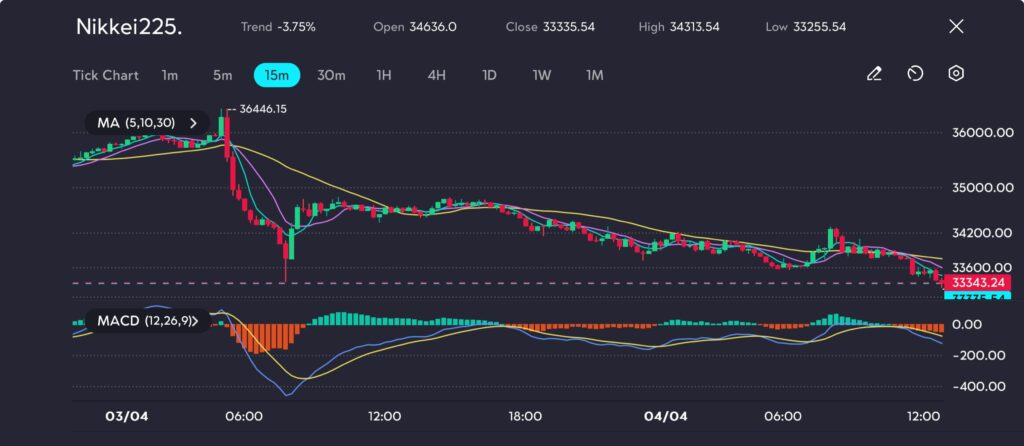
Key Points:
- Nikkei 225 index drops 3.75%, reaching 33,335.54.
- The Nikkei 225 index faces its steepest weekly loss in five years.
- Market sentiment remains fragile as global trade tensions continue to rise.
Nikkei 225 Drops Sharply Following U.S. Tariff Announcement
The Nikkei 225 index continued its decline on Thursday, closing at 33,335.54, down 3.75% for the day. This is part of a broader trend, with the index on track for its sharpest weekly drop in five years, reflecting increasing fears of a global recession triggered by U.S. President Donald Trump’s latest trade tariffs.
Trump’s Tariffs Weigh on Market Sentiment
The market response came after President Trump’s announcement of new tariffs on all imports to the U.S., including a 10% baseline tariff with higher rates on specific countries. The move sent ripples through global markets, further exacerbating fears of an economic slowdown. As global trade tensions heighten, Market participants are flocking to safe-haven assets such as gold and the yen, further increasing downward pressure on Japanese stocks.
Banking Sector Takes a Hit
The banking sector, a significant component of the Nikkei 225, suffered the most significant losses, with shares down by 11%. Mitsubishi UFJ Financial Group saw a substantial drop of 11.6%, its largest single-day decline since August 5. The Bank of Japan may now be forced to delay any potential interest rate hikes, adding to the sector’s woes.
Technical Outlook

Picture: Nikkei 225 tests support at 33,343 after a steep decline from 34,446, as seen on the VT Markets app.
Nikkei 225 declined by 3.75%, closing at 33,335.54 after opening at 34,636. The session saw a sharp drop, reaching a low of 33,255.54 before slightly retracing to close near 33,335.
The moving averages (MA 5,10,30) suggest bearish momentum, with short-term MAs below the longer-term moving averages. This crossover indicates that the downward price movement may persist. The MACD (12,26,9) is also reflecting the bearish sentiment, with the histogram showing an increasing amount of negative momentum, and the MACD line (blue) remains below the signal line (yellow).
Key levels to monitor include 33,343 as immediate support and 34,446 as resistance. A break below support could signal further downside momentum, while a rally above resistance could shift the sentiment to a more neutral or bullish stance.
With the possibility of a prolonged trade war and slow economic growth, market participants remain cautious. Nikkei 225 traders are closely monitoring any new developments, as the broader impact of tariffs continues to unfold.









